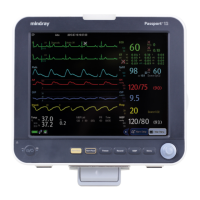Passport 12/Passport 8 Operator’s Manual 7-7
WARNING
Make sure that the alarm limit settings are appropriate for your patient before monitoring.
Setting alarm limits to extreme values may cause the alarm system to become ineffective. For example, high
oxygen levels may predispose a premature infant to retrolental fibroplasia. If this is a consideration, do NOT
set the high alarm limit to 100%, which is equivalent to switching the alarm off.
When monitoring patients that are not continuously attended by a clinical operator, properly configure the
alarm system and adjust alarm settings as per the patient's condition.
7.5.2 Adjusting Alarm Limits Automatically
The monitor can automatically adjust alarm limits according to the measured vital signs. When auto limits are selected,
the monitor calculates safe auto limits based on the latest measured values.
To get accurate auto alarm limits, you need to collect a set of measured vital signs as a baseline. Then, in the [Main
Menu], select [Alarm Setup >>]→[Parameters]→[Auto Limits] →[Ok]. The monitor will create new alarm limits based
on the measured values.
Before applying these automatically created alarm limits, confirm if they are appropriate for your patient in the [Alarm
Setup Menu]. If not, you can adjust them manually. These alarm limits will remain unchanged until you select auto limits
again or adjust them manually.
The monitor calculates the auto limits based on the following guidelines:
Module Parameter
Low alarm limit High alarm limit
Auto alarm limits
range
Adult/
pediatric
Neonate
Adult/
pediatric
Neonate
ECG HR/PR
(HR × 0.8) or 40
bpm (whichever is
greater)
(HR – 30) or 90
bpm (whichever is
greater)
(HR × 1.25) or 240
bpm (whichever is
smaller)
(HR + 40) or 200
bpm (whichever is
smaller)
Adult/pediatric: 35 to
240
Neonate: 55 to 225
Resp RR
(RR × 0.5) or 6 rpm
(whichever is
greater)
(RR – 10) or 30 rpm
(whichever is
greater)
(RR × 1.5) or 30
rpm (whichever is
smaller)
(RR + 25) or 85 rpm
(whichever is
smaller)
Adult/pediatric: 6 to
55
Neonate: 10 to 90
SpO
2
SpO
2
Same as the
default alarm limit
Same as the
default alarm limit
Same as the
default alarm limit
Same as the default
alarm limit
Same as the
measurement range
NIBP
NIBP-S
(SYS × 0.68 + 10)
mmHg
(SYS – 15) or 45
mmHg (whichever
is greater)
(SYS × 0.86 + 38)
mmHg
(SYS + 15) or 105
mmHg (whichever
is smaller)
Adult: 45 to 270
Pediatric: 45 to 185
Neonate: 35 to 115
NIBP-D
(Dia × 0.68 + 6)
mmHg
(Dia – 15) or 20
mmHg (whichever
is greater)
(Dia × 0.86 + 32)
mmHg
(Dia + 15) or 80
mmHg (whichever
is smaller)
Adult: 25 to 225
Pediatric: 25 to 150
Neonate: 20 to 90
NIBP-M
(Mean × 0.68 + 8)
mmHg
(Mean – 15) or 35
mmHg (whichever
is greater)
(Mean × 0.86 +
35) mmHg
(Mean + 15) or 95
mmHg (whichever
is smaller)
Adult: 30 to 245
Pediatric: 30 to 180
Neonate: 25 to 105

